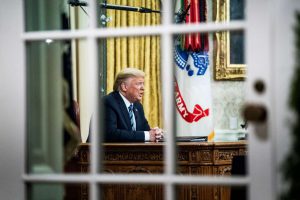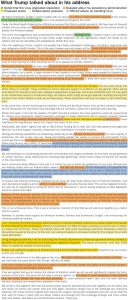MARCH 11, 2020

President Donald J. Trump delivers a television national address on the coronavirus COVID-19 pandemic announcing a travel ban between U.S. and most of Europe from the Oval Office at the White House on Wednesday, March 11, 2020 in Washington, DC. (Jabin Botsford/The Washington Post)
President Trump’s address to the nation about the spread of the novel coronavirus was clearly aimed at conveying a sense of an administration with a firm grip on the growing crisis.
He outlined several new proposals, including a surprising ban on travel from most of the European Union (but not, inexplicably, from the United Kingdom, which has one of the largest numbers of cases in the region). He spent some time advising Americans on how to deal with the virus — washing hands and limiting visits to nursing homes, among other things. And he spent a good deal of time making the case for how his administration had already demonstrated exceptional strength in approaching the outbreak.
We took the text of Trump’s speech and color-coded it. His new proposals are in yellow and his advice to Americans in blue. His efforts to promote his administration’s actions both on the coronavirus and the economy are in orange. In green, two instances in which he pointedly mentioned that the virus originated overseas. More on that in a second.

The visual effect makes the point clearly. A lot of Trump’s speech was aimed at bolstering perceptions of his handling of the government, an apparent attempt to immediately quell investor concerns manifested in sharp drops in stock prices. Market futures dropped quickly as Trump spoke.
His mentions of the “foreign virus” having “started in China” have their own rationale. One reason for noting the point of origin of the outbreak is to counteract China’s apparent willingness to let its citizens believe that the virus originated in the United States. The other reason is that Trump and his allies clearly want to remind Americans that this is a crisis not of Trump’s making, however one views how he’s handled it since it emerged.
Trump’s efforts to outline new proposals had their own issues. At one point, he announced that the ban on travel between the E.U. and the United States would “not only apply to the tremendous amount of trade and cargo, but various other things as we get approval.” The economic ramifications of that would be significant — but the White House later clarified that cargo was excepted. (Some European officials indicated that they didn’t know this step would be announced.)
At another point, Trump announced that “leaders of [the] health insurance industry . . . agreed to waive all co-payments for coronavirus treatments.” They haven’t.
What Trump’s speech didn’t include was any significant announcement about controlling the spread of the virus inside the United States. There were no blanket recommendations about how to approach large events, just mentions of how the White House is working with the most affected communities. That, of course, is a dubious measure; the lack of widespread testing means that some communities may have far more cases than are known.
On that point, Trump both pledged that “testing and testing capabilities are expanding rapidly day by day” and that “we have seen dramatically fewer cases of the virus in the United States than are now present in Europe” — an obvious contradiction given that the paltry level of testing means that we’re almost certainly understating the number of cases in the United States.
The oversight that might prove the most problematic was Trump’s failure to announce any plan for dealing with a surge in hospitalizations linked to covid-19, the disease caused by the virus. As cases spike, hospitals will be increasingly strained as they try to respond. It’s this strain that may be the largest factor in increasing the number of deaths. Trump didn’t mention it.
He did, however, mention multiple times that his team and our economy are the best in the world. Those claims are likely to be tested over the next few weeks.
Courtesy/Source: Washington Post

































































































